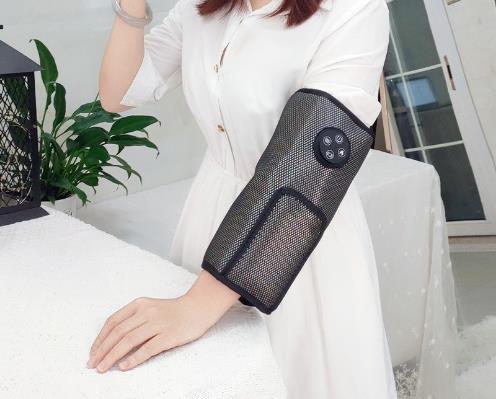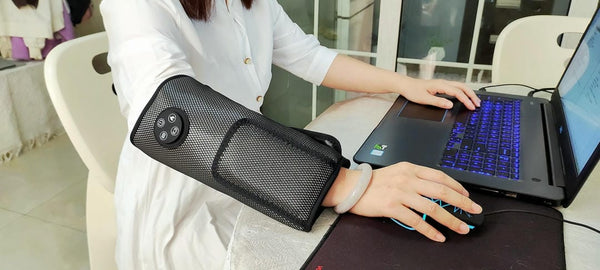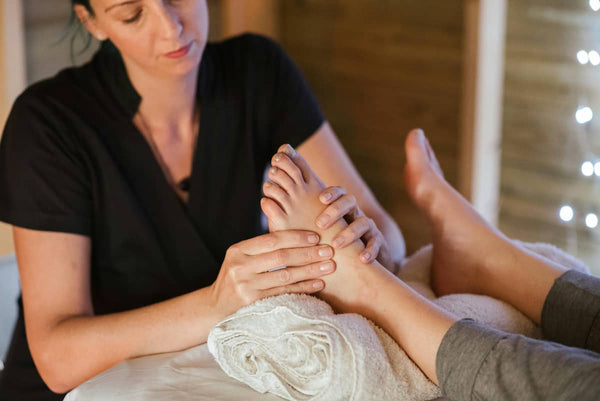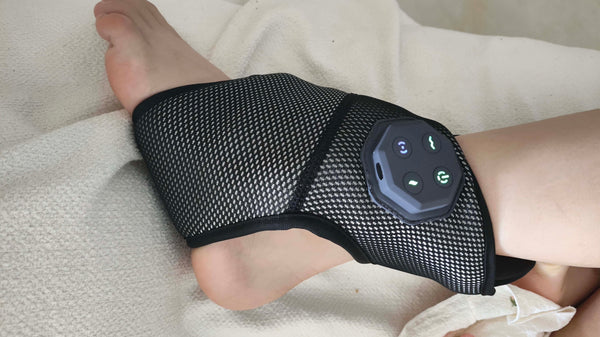 Choosing the right type of massage can often feel like navigating a complex map, especially when you're seeking relief from chronic discomfort or simply aiming to improve your overall well-being. For many middle-aged and elderly individuals, understanding the distinctions between terms like Acupressure Massage, Acupoint Massage, and Deep Tissue Massage is key to finding a therapy that truly meets their specific needs. Each of these modalities offers unique benefits, but they also differ significantly in their approach and intensity. It's not just about a 'massage'; it's about finding the right therapeutic touch.
Choosing the right type of massage can often feel like navigating a complex map, especially when you're seeking relief from chronic discomfort or simply aiming to improve your overall well-being. For many middle-aged and elderly individuals, understanding the distinctions between terms like Acupressure Massage, Acupoint Massage, and Deep Tissue Massage is key to finding a therapy that truly meets their specific needs. Each of these modalities offers unique benefits, but they also differ significantly in their approach and intensity. It's not just about a 'massage'; it's about finding the right therapeutic touch.
This article aims to provide a clear, easy-to-understand comparison of these three popular massage techniques. We'll delve into what each involves, their underlying principles, and the conditions they are best suited to address. My years of experience in physiotherapy, particularly with an understanding of meridians and acupoints, have shown me that an informed choice can make a world of difference in achieving therapeutic goals. Let's explore these options to help you decide which path might be best for you.
What is Acupressure Massage?
Acupressure Massage is a therapeutic technique rooted in Traditional Chinese Medicine (TCM). It involves applying manual pressure—using fingers, thumbs, elbows, or specialized devices—to specific points on the body known as acupoints. These points are situated along pathways called meridians, through which Qi (vital life energy) is believed to flow. The core principle is that blockages or imbalances in Qi flow can lead to pain, illness, or general discomfort. Acupressure Massage aims to clear these blockages and promote a smooth, harmonious flow of Qi, thereby supporting the body's natural healing abilities and enhancing overall wellness.
According to one common perspective rooted in traditional Chinese medicine, Acupressure Massage therapy is particularly well-suited for promoting energy flow and inducing overall relaxation. Many users appreciate its characteristic rhythmic pressure and the gentle stretching that is often incorporated. This makes it a favored choice for individuals seeking a less intense, holistic approach to de-stress and rebalance, which can be especially beneficial for middle-aged and elderly people looking for gentle yet effective relief. It's often sought for its calming effects on the nervous system and its ability to alleviate general tension.
- Focus: Restoring energy balance, promoting overall relaxation, and reducing stress.
- Technique: Rhythmic pressing, kneading, and sometimes gentle stretching applied to acupoints along the body's meridians.
- Sensation: Typically gentle to moderate pressure, aiming for a deeply relaxing and balancing experience.
What is Acupoint Massage?
Acupoint Massage, while closely related to Acupressure Massage as both stem from TCM and work with acupoints, often implies a more focused and targeted application. If a general Acupressure Massage session might address multiple meridians for overall balance, Acupoint Massage tends to concentrate on specific acupoints directly related to a particular ailment or area of pain. Think of it as a specialized treatment within the broader field of acupressure therapies.
This targeted approach is considered ideal for localized problems. For example, individuals suffering from tension headaches, specific joint pain like in the knees or shoulders (common concerns for middle-aged and elderly people), or localized leg pain might benefit significantly from Acupoint Massage. Practitioners will identify and work on the precise points known in TCM to influence that specific condition or body part. Many users have shared successful experiences where such targeted Acupoint Massage has provided notable relief from tension and localized pain, sometimes quite rapidly. The pressure applied can be firm and sustained on these key points to elicit a therapeutic response.
- Focus: Relieving specific, localized pain or symptoms by stimulating precise acupoints.
- Technique: Direct, often sustained pressure or manipulation on individual acupoints relevant to the complaint.
- Sensation: Can range from a dull ache to a more intense "deqi" sensation (a feeling of soreness, tingling, or fullness) at the point, which is often considered a sign of effective stimulation.
 What is Deep Tissue Massage?
What is Deep Tissue Massage?
Deep Tissue Massage is a Western massage modality that focuses on the deeper layers of muscle and connective tissue, known as fascia. Its primary aim is to address chronic patterns of tension in the body, break down scar tissue, and release muscle adhesions (often called "knots"). This technique involves slower strokes and more intense, focused pressure than classic relaxation massage. It's often recommended for individuals with chronic pain, limited mobility due to muscle tightness, or those recovering from certain types of injuries. It can be particularly beneficial for stubborn muscle tension that hasn't responded to gentler methods.
Many believe Deep Tissue Massage is highly effective for chronic muscle tension and injury, though it is recognized for its intensity. It's a popular choice for athletes, but also for individuals, including middle-aged or elderly people with long-standing postural issues or persistent nodules, who are seeking substantial relief. Users often report tangible benefits such as significant pain reduction, improved sleep quality, and a profound sense of physical relaxation once the initial intensity passes. Anecdotal experiences frequently highlight improvements in conditions like chronic back pain and overall stress levels after consistent treatment. However, it's important to communicate with your therapist, as the pressure can be quite strong.
- Focus: Releasing chronic muscle tension, breaking down adhesions (knots), and improving range of motion.
- Technique: Slow, deliberate strokes with deep, concentrated pressure, often applied across the grain of the muscles or to specific trigger points.
- Sensation: Can be intense and sometimes uncomfortable, especially over tight or adhered areas. Some soreness after the massage is not uncommon.
Key Differences: Comparing Acupressure Massage, Acupoint, and Deep Tissue
Understanding the core distinctions between Acupressure Massage, Acupoint Massage, and Deep Tissue Massage is crucial for selecting the most appropriate therapy. While all aim to alleviate discomfort and promote well-being, their underlying philosophies, techniques, and primary targets differ significantly. From a physiotherapy perspective grounded in both traditional and modern understanding, the approaches diverge mainly in their view of the body's functioning and the source of dysfunction.
Here's a simplified breakdown:
-
Theoretical Framework:
- Acupressure Massage & Acupoint Massage: Based on Traditional Chinese Medicine principles of Qi (vital energy) and meridians (energy pathways). The goal is to restore balanced energy flow.
- Deep Tissue Massage: Based on Western anatomy and physiology, targeting the physical structure of muscles, fascia, and connective tissues.
-
Primary Goal & Application:
- Acupressure Massage: Best for overall relaxation, stress reduction, and gentle energy balancing. Often preferred by those sensitive to deeper pressure, including many middle-aged and elderly individuals. It can be a good answer to finding the best massage type for stress relief.
- Acupoint Massage: Best for targeted relief of specific pains or symptoms (e.g., headaches, localized joint pain) by stimulating precise points.
- Deep Tissue Massage: Best for chronic, deep-seated muscle tension, adhesions, and injury recovery. Addresses the question of "Which is better for muscle pain: acupressure or deep tissue?" when pain is due to structural muscle issues.
-
Typical Sensation & Pressure:
- Acupressure Massage: Generally moderate, rhythmic pressure; often very relaxing.
- Acupoint Massage: Can be intense at specific points, aiming for a therapeutic sensation.
- Deep Tissue Massage: Sustained, intense pressure; can be uncomfortable but ultimately relieving for deep tension.
Which Massage Best Suits the Needs of Middle-Aged and Elderly People?
For middle-aged and elderly individuals, the choice of massage often hinges on specific health concerns such as arthritis, chronic pain, reduced mobility, circulatory issues, or the need for stress management and improved sleep. Acupressure Massage, with its generally gentler approach and focus on holistic balance, can be an excellent option. It can help improve circulation, reduce stress, and alleviate mild aches and pains without being overly strenuous on the body. Its calming effect can also contribute to better sleep patterns.
Acupoint Massage can be particularly beneficial if there are specific, localized issues, such as osteoarthritic pain in a particular joint or persistent headaches. By targeting the relevant acupoints, it can offer focused relief. Deep Tissue Massage might be considered for more severe, chronic muscular tension or long-standing postural problems, but it should be approached with caution. It's vital that the therapist is experienced in working with older adults and can adjust the pressure to a tolerable and safe level, especially if conditions like osteoporosis or increased skin fragility are present. Clear communication about comfort levels is absolutely essential. Many find that a skilled therapist can adapt techniques from any modality to suit the needs of an older client, perhaps blending approaches.
Ultimately, the best massage for specific conditions in this demographic involves a careful assessment of individual health status and preferences. A combination of techniques or a modified approach is often the most effective. For instance, gentle rocking and stretching often incorporated in Acupressure Massage can be very beneficial for joint mobility.
Considering Alternatives and Practicalities
While professional massage offers significant benefits, practical considerations like the "Cost comparison of massage types" and accessibility to skilled therapists are valid concerns. Generally, specialized treatments like deep tissue massage might have a different cost structure compared to a standard Acupressure Massage, though this varies by region and practitioner. The frequency of sessions needed also impacts overall cost, which can be a factor for those on a fixed income, a common situation for some middle-aged and elderly individuals.
This brings us to an important perspective: if finding a suitable skilled therapist is challenging or if costs are prohibitive, alternative tools can be considered. This is where the discussion of "DIY massage vs professional" becomes relevant. While home-use devices cannot fully replicate the nuanced skill of a trained therapist, they can offer valuable support. For instance, modern massagers like the KLCOSY brand, which aim to simulate techniques such as massage and moxibustion by integrating meridian theory with technology, can provide accessible relief for daily aches and pains. Such tools can be particularly useful for managing chronic discomfort, improving circulation, or simply promoting relaxation at home. As someone dedicated to bridging traditional principles with modern innovation, I see great potential in these tools for empowering individuals in their self-care routines, offering a way to consistently apply beneficial stimulation that aligns with the needs of different constitutions.
When considering such alternatives, it's wise to:
- Research devices that suit your specific needs (e.g., for back, neck, or feet).
- Look for features that allow for adjustable intensity.
- Read user reviews and, if possible, try a device before purchasing.
Choosing between Acupressure Massage, Acupoint Massage, and Deep Tissue Massage is a personal decision that should be guided by your specific health needs, preferences, and desired outcomes. For middle-aged and elderly individuals, factors like comfort, existing health conditions, and the goal of the massage—be it general relaxation, targeted pain relief, or addressing chronic muscular issues—play a significant role. Acupressure Massage often provides a gentle yet effective path to balance and stress relief, while Acupoint Massage offers precision for localized complaints. Deep Tissue Massage, though more intense, can be invaluable for stubborn muscular problems when applied judiciously.
It's always recommended to discuss your health history and goals with a qualified massage therapist who can help you make the most informed choice and tailor the treatment accordingly. And remember, the integration of traditional wisdom with modern technological aids, like thoughtfully designed home massagers, can also offer very practical and beneficial avenues for maintaining well-being. The key is to find what works best for your body and lifestyle, paving the way for sustained comfort and vitality.
Frequently Asked Questions (FAQ)
What type of massage is best for sciatica?
Sciatica, characterized by pain radiating along the sciatic nerve, often requires a careful approach. The "best" massage depends on the underlying cause. For some, gentle Acupressure Massage techniques aimed at relaxing the lower back and hip muscles, and improving overall energy flow in the area, can be beneficial. Targeted Acupoint Massage on specific points known in TCM to alleviate sciatic pain may also provide relief. If piriformis syndrome (where the piriformis muscle compresses the sciatic nerve) is the culprit, a skilled therapist might use modified deep tissue or trigger point techniques very cautiously to release tension in that specific muscle. However, direct deep pressure over an inflamed sciatic nerve should generally be avoided. It is crucial for middle-aged and elderly individuals to consult their doctor for a proper diagnosis first. A therapist experienced with sciatica will tailor the massage, possibly using gentle stretches and ensuring the pressure is always comfortable and never exacerbates the pain.
How many massage sessions do I need?
The number of massage sessions needed varies greatly from person to person. For an acute issue, you might feel significant improvement after just 1-3 sessions. For chronic conditions, which are more common in middle-aged and elderly people, a series of sessions is often more beneficial. For instance, weekly sessions for 4-6 weeks might be suggested initially to achieve a noticeable reduction in pain or improvement in mobility. After this initial period, the frequency can often be reduced to maintenance sessions, perhaps once every 2-4 weeks, or as needed. Factors like the specific condition, its severity, how long you've had it, your overall health, and how your body responds to Acupressure Massage or other therapies all play a role. Your therapist should discuss a treatment plan with you after your first or second session.
Can massage therapy replace medication?
Massage therapy, including Acupressure Massage, can be a valuable part of a pain management or wellness plan, and may help reduce the need for certain medications, such as pain relievers or muscle relaxants, for some individuals. Many middle-aged and elderly people find it helps manage chronic pain and improves quality of life. However, massage therapy should generally be considered a complementary therapy, not a replacement for medications prescribed by your doctor, especially for underlying medical conditions like heart disease, diabetes, or severe arthritis. It is essential to never stop or change your medication dosage without consulting your physician. Massage can work alongside medical treatments to enhance overall well-being and alleviate symptoms, but decisions about medication should always be made in consultation with your healthcare provider.




0 comments